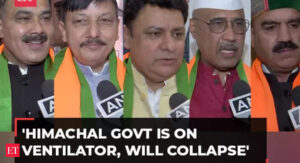2 November 1990: When ‘Mullah Mulayam’ ordered police to fireside on Hindu devotees at Ayodhya
5 min read2 November 2021 marked the thirty first anniversary of the day when horrifying brutality was meted out on hundreds of Karsevaks and Hindu devotees who had gathered on the then disputed Babri construction website to reclaim the Janmabhoomi(birthplace) of Lord Rama.
It was the results of the sacrifice made by them on 2 November 1990 that fuelled the protests for reclamation of Lord Rama’s birthplace and culminated into the felling of the controversial construction in Ayodhya greater than 2 years later, on December 6, 1992, when hundreds of karsevaks scaled the partitions of the Babri construction introduced it to floor.
However, it took one other 27 agonising years for Hindus to win the many years lengthy dispute over the possession of the disputed land in Ayodhya. In 2019, the Supreme Court of India put an finish to the lengthy authorized battle and awarded the land to the Hindus, paving the way in which for the development of a bhavya(magnificent) Ram Mandir in Ayodhya.
Nevertheless, the day, November 2, holds particular significance for pious Hindu devotees who view it as a tipping level within the lengthy and arduous battle to reclaim the abode of Ram Lalla. This 12 months, the day coincided with Dhanteras, the primary day of the Diwali festivities. Also often called the competition of lights, Diwali marks the homecoming of Lord Rama after spending 14 years in exile. On at the present time yearly, thousands and thousands of Hindus world wide adorn their houses with diyas and lights to have fun the return of Lord Rama to Ayodhya.
What occurred on 2 November 1990?
On 2 November 1990, orders from the powers that be to then IG SMP Sinha had been clear. The Mulayam Singh authorities in Uttar Pradesh reportedly requested him to clear the streets occupied by karsevaks who had been peacefully demonstrating to reclaim Ram Janmabhoomi. Sinha advised his subordinates: There is a transparent instruction from Lucknow that the gang is not going to sit on the streets at any price.
It was 9 am on the auspicious day of Kartik Purnima when Hindu saints and hundreds of karsevaks, comprising additionally of girls and aged folks, resumed their march in direction of the Ram Janmabhoomi website the place the disputed construction then stood. The safety forces, who had been instructed to cease the Hindus from reaching the location, lined up on the street to dam the way in which.
Whenever the safety personnel tried to impede the Hindu devotees, they’d sit there and begin chanting the identify of Lord Ram and reciting Bhajans (non secular songs). They touched the toes of the safety personnel, deployed to stop them from marching forward. Each time they did this the safety personnel would transfer again and the karsevaks would transfer ahead. Though unarmed, the karsevaks remained undeterred.
This saved taking place in a loop till the IG handed orders and the police personnel sprung to motion. Tear fuel shells had been fired, lathis had been rained on the karsevaks, however the resolute Ram Bhakts neither counter-attacked nor did they agitate or falter. Suddenly the safety personnel began responding by opening hearth. Many Hindu devotees had been focused and gunned down. It’s believed that the safety personnel hunted and focused Hindus in each lane and bylane resulting in the Ram Janmabhoomi and inside no time the streets transformed right into a struggle zone.The safety personnel neither provided assist to the injured nor allowed anybody else to assist them.
The police didn’t have any prior written order for firing. In truth, the district Justice of the Peace had signed the order after the police had carried out the firing. No karsevak was shot within the leg. All of them had been shot within the head and chest. Which signifies that the safety personnel had fired with an intention to kill and never injure.
Media headline in November 1990, stating that indiscriminate firing was ordered on the KarsevaksKothari brothers, the face of Ram Janmabhoomi motion, perished within the 2 November 1990 onslaught
It was on this carnage that the heroic Kothari brothers, who later turned the face of the Ram Janmabhoomi motion, attained martyrdom. They had gathered in entrance of Hunumangarhi, a stone’s throw away from the disputed construction that was finally demolished later. As the protesters sat on the street in protest and began singing non secular hymns.
Out of the blue, safety personnel on the behest of the then CM Mulayam Singh, began firing on the crowd and chased karsevaks throughout the world. Many folks died from head wounds. There was a stampede on the Saryu Bridge, which killed quite a few folks. According to eye-witnesses, the Kothari brothers had mounted a saffron flag atop the Babri construction, however nevertheless, fell prey to the brutality meted out on the Karsevaks.
The loss of life toll of karsevaks and Hindu devotees
The incident which occurred in Ayodhya, virtually 30 years again, left an indelible mark within the historical past of India. After the brutal bloodbath, totally different media homes had provide you with totally different numbers of these killed on November 2, 1990. In a report printed the following day by Jansatta, the variety of useless karsevaks was acknowledged to be 40. It had additionally acknowledged that 60 others had been badly wounded within the incident whereas it couldn’t give the precise quantity of people that escaped with minor accidents. Meanwhile, a journalist who was on the spot through the incident, reported the loss of life toll to be 45.
The Hindi every day Dainik Jagran had mentioned that 100 folks had died within the police firing, whereas Daily Aaj mentioned this quantity was 400. Though the official report on the incident concluded that 16 folks had been killed within the firing, nevertheless, the actual fact remained that the quantity was doubtlessly far larger. The incident was even in comparison with unbiased India’s Jallianwala Bagh bloodbath.
‘Mullah Mulayam’ stands by his resolution, says safety forces may have killed extra if required
The firing came about on the specific orders of then chief minister Mulayam Singh Yadav. On the morning of October 30, the police had barricaded about 1.5 km-long pathway to the disputed construction. Ayodhya was in an unprecedented safety cordon. Curfew had been imposed. Yet, sadhus and Karsevaks marched in direction of the construction.
By midday, police acquired orders from then Chief Minister Mulayam Singh Yadav to open hearth on the karsevaks. The firing led to chaos and stampede. Police chased down the karsevaks within the streets of Ayodhya.
Another spherical of conflict erupted on November 2, when the karsevaks got here again and resumed their march in direction of the Ram Janmabhoomi website.
Mulayam Singh Yadav earned the sobriquet ‘Mullah Mulayam’ by the Muslim neighborhood for issuing orders to fireside at karsevaks. In 2017, the Samajwadi Party patriarch stood by his resolution of asking the forces to fireside upon the karsevaks marching in direction of Ayodhya. If this wasn’t sufficient, including insult to the harm, Mulayam Singh Yadav quipped, “If more people were required to be killed for the sake of the country’s unity and integrity, the security forces would have done it.”






